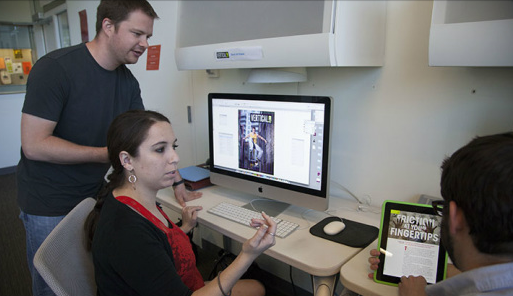Home > Teaching: Syracuse University > MNO 631: Capstone Experience: Journalism Enterprise
MNO 631: Capstone Experience: Journalism EnterpriseThis is the capstone experience for graduate magazine, newspaper, and online journalism majors. Students will devote 200 hours per term as part of a reporting/writing/editing team. Students will produce a publishable journalism project.
Student Learning Outcomes
The Major Assignment Create, write, photograph, edit, design, and publish a digital magazine (view past MNO capstone magazines). We will be one unified team. No print side and web side. Just one team. The professors will help you focus your assignments, offer story ideas, help create editorial fixtures, and conceptualize multimedia extensions. But the students in this class will create the tablet magazine — write it, edit it, design it — along with all the coding, writing, designing, shooting the photography and capturing and editing the video, audio, and slideshows. Integral to all those tasks are these traits: the ability to work together effectively, to do whatever needs to be done (regardless of its perceived importance), and to listen to and act on feedback from peers and professors. Remember: It is better to engage with your professors the moment you reach a snag (can't find a source, your writer turns in crap, or the video stinks), than to cripple along in silence and frustration until the problem is large and we're late in the process. Finally, I expect professionalism. The Environment We will meet Monday through Friday in the Collaborative Media Room and the War Room, and we will operate like the editorial offices of a magazine. You are expected to show up on time for every class and to work -- just like any other class. For the first week, expect to be ready to go at 9 a.m.; after that, we might consider a later start time. We will meet first thing in the morning to brainstorm and plan out the day's workload and assignments. The class then spends the rest of the day working on the project. Fridays, as a rule, will be the most flexible of the lot, and I’ll spring for pizza for everyone on those days. By the end of the first week, students will be working on assignments and possibly be out of the classroom (the person who becomes managing editor will create a detailed schedule of deadlines, but I expect to see the first draft of departments and a generous amount of art concepts the second week of class). If you want to brainstorm, write, research, shoot photography, or perform any other editorial activity outside of the lab, you must inform me and the editor (possibly more bodies, depending on the editorial structure). It is critical that the staff knows where you are during the hours of this class. Editorial emergencies arise and the need for discussion and problem resolution become urgent. So keep us informed about your whereabouts and how to contact you. For the record, you are required to spend a minimum of 40 hours a week working on the Capstone. Finally, I have two additional requests: a weekly memo handed to me each Friday by noon that outlines what you accomplished that week and an individual performance review during the final week of the class (where you will articulate what you signed on for, what you did, where you went beyond those assignments, and what you consider your greatest strength, greatest weakness). Both of these will be critical in the determination of your final grade. |
MNO Capstone WebsiteCreative Department
The Creative Department is responsible for the development of the magazines branding, layout, artwork, photography and interactivity. Check out a complete list of job descriptions in the Creative Department.
|



